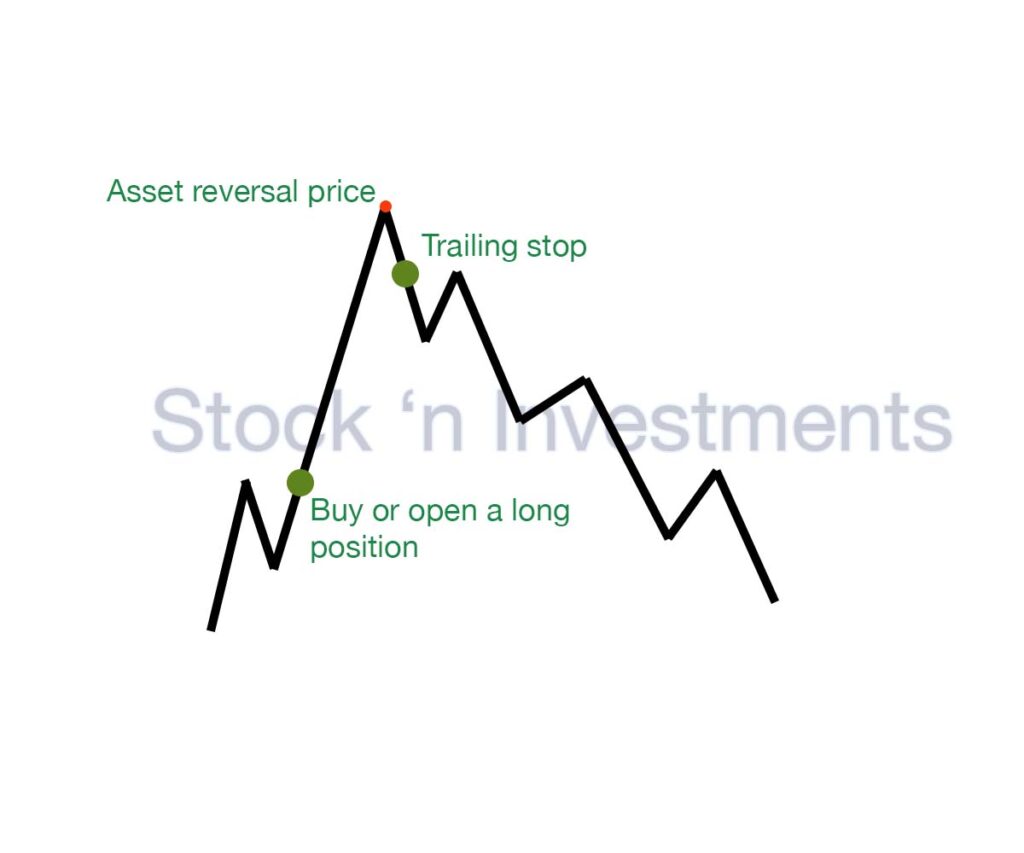A trailing stop (TS) is a powerful stock market tool that helps traders automatically protect their profits and limit losses as the price of an asset moves in a favorable direction. Unlike a fixed stop-loss, a TS dynamically adjusts, maintaining a set distance from the current market price.
What is a trailing stop?
A TS order, or TS loss, is a type of stop-loss order that automatically adjusts its level according to the price movement in a favorable direction. As soon as the price moves in your favor, the stop-loss moves along with it, maintaining the set distance.
How does a trailing stop loss work?
When you set a TS loss, you specify how far away from the current price your stop-loss should remain. For example, if you bought shares at $100 and set a TS loss with a distance of $5, your initial stop-loss would be at $95. If the price rises to $110, the stop-loss automatically moves to $105.
A trailing stop limit is similar to a TS loss but includes a limit price. When the trigger price is reached, a limit order is placed at the specified price instead of a market order.
Using trailing stops on different platforms
NinjaTrader trailing stop
On the NinjaTrader platform, you can set up a TS through the order properties. NinjaTrader allows traders to fine-tune TS parameters for different trading strategies.
Fidelity trailing stop loss
Fidelity also offers the option to set TS loss orders. This allows clients to automatically adjust their stop-loss orders according to market price movements, reducing the need for constant monitoring.

How to Set a TS Loss Order?
Determine the Distance or Percentage. Choose a fixed amount or percentage by which the TS will follow the current price.
Place the Order: On your trading platform, select the asset and set a TS loss order. For example, if you are trading on Fidelity, select the order type “Trailing Stop” and enter the distance.
Monitor and Adjust: After placing the order, it will automatically follow the market price. It’s important to periodically check and adjust the parameters according to market conditions.
Does a trailing stop order exist on Binance?
Yes, Binance offers the option to use TS orders. This feature allows traders to automatically adjust their stop-loss based on market price movements, helping to protect profits and limit losses.
How to use it on Binance?
In the trading interface, select the order type “Trailing Stop”.
Set Parameters for your order:
- Trailing Delta (T/D(%)). Set the distance (in percentage or a fixed amount) that the TS will follow the market price.
- Limit. It defines the price at which you are willing to execute the order once the stop price is triggered. This ensures that the order will only be executed at this specified price or better.
- Quantity: Specify the quantity of the asset for which the order will be applied.
After setting all parameters, click the confirmation button to place the order.
Is it worth using a trailing stop in trading?
Using TS orders in trading is an important tool for risk management and profit protection. It offers an automatic stop-loss adjustment mechanism that helps traders be more confident in their decisions and reduces emotional stress during trading. Whether you are a beginner or an experienced trader, a TS can be a valuable addition to your trading strategy.
When Should You Use It?
Volatile markets. When prices are actively moving, a trailing stop can help lock in profits and limit losses in high volatility conditions.
Trending markets. If you expect the price to move in a certain direction for an extended period, a TS can help maximize profit by following the trend.
What example can be given?
Suppose you bought shares at $100 and set a ST 5% below the current price. If the share price rises to $120, your ST will automatically move to $114 (5% below the highest achieved price). When the share price then drops to $114, your order will be executed, securing your profit of $14 per share. If the price continues to rise, your TS will keep adjusting, following the price by 5%.
How does a trailing stop protect against losses?
When the asset price moves in a favorable direction, the TS automatically adjusts its level, following the price at a certain distance (percentage or fixed amount). For example, if you set a TS 5% below the current price, and the price increases, the stop-loss will also rise, staying 5% below the highest achieved price.
Should trailing stops be used during breakouts in stock market patterns?
Using a trailing stop during a breakout in stock market patterns can be a beneficial strategic approach. However, it’s important to consider that using a TS requires careful analysis of market conditions and the pattern itself. It can be a useful tool for traders who avoid emotional decisions and employ risk management strategies.
Conclusion
Using TS, TS loss, and TS limit orders is a key strategy for traders who aim to minimize losses and automatically protect profits. Whether using a NinjaTrader TS or a Fidelity TS loss, these tools provide flexibility and convenience, helping traders adapt to dynamic market conditions. Understanding the trailing stop meaning and correctly applying these orders can significantly enhance your trading effectiveness.